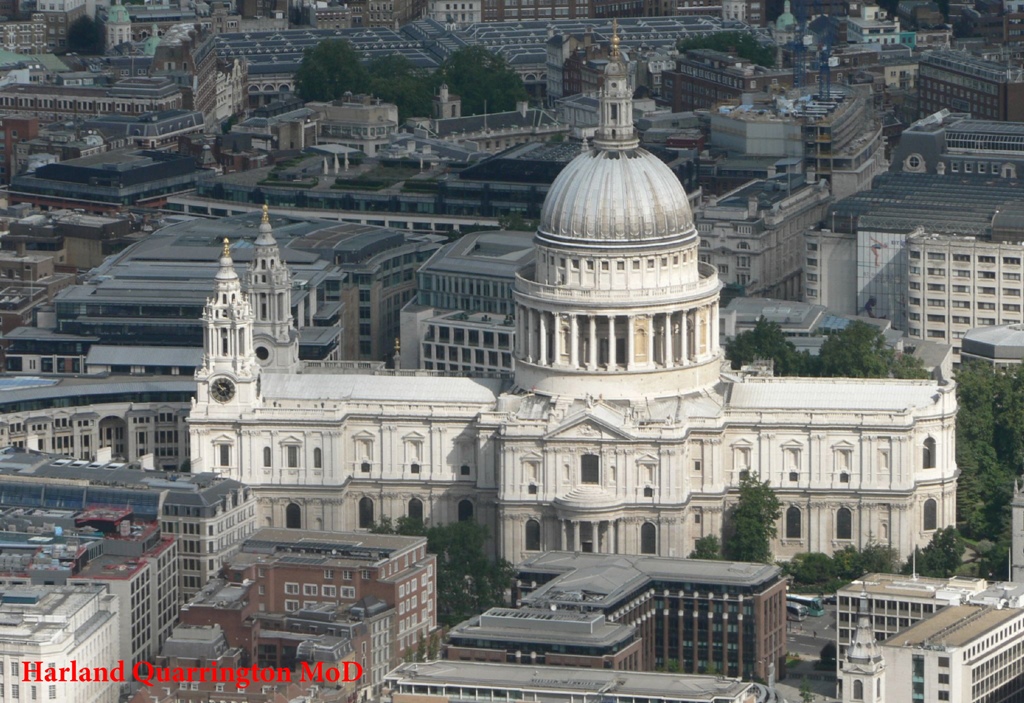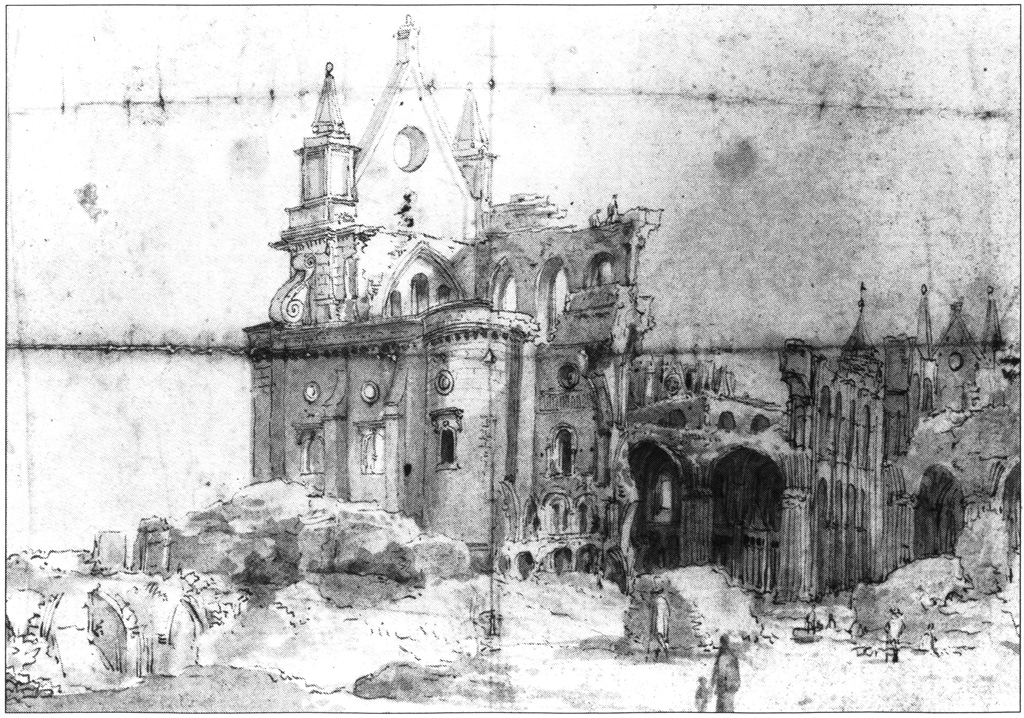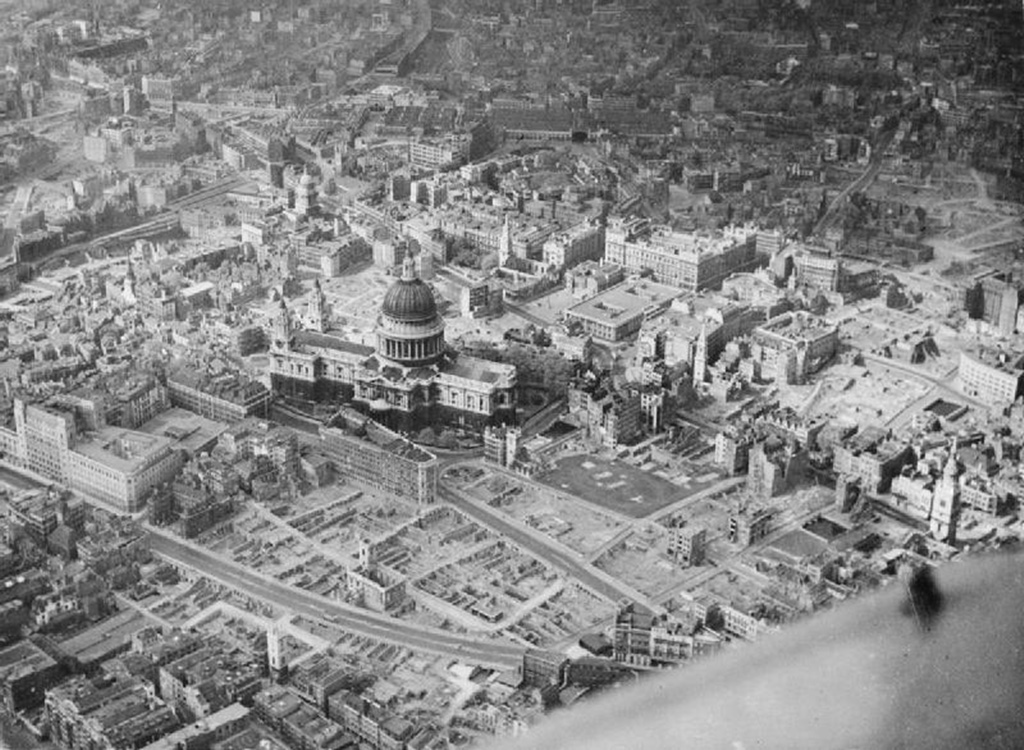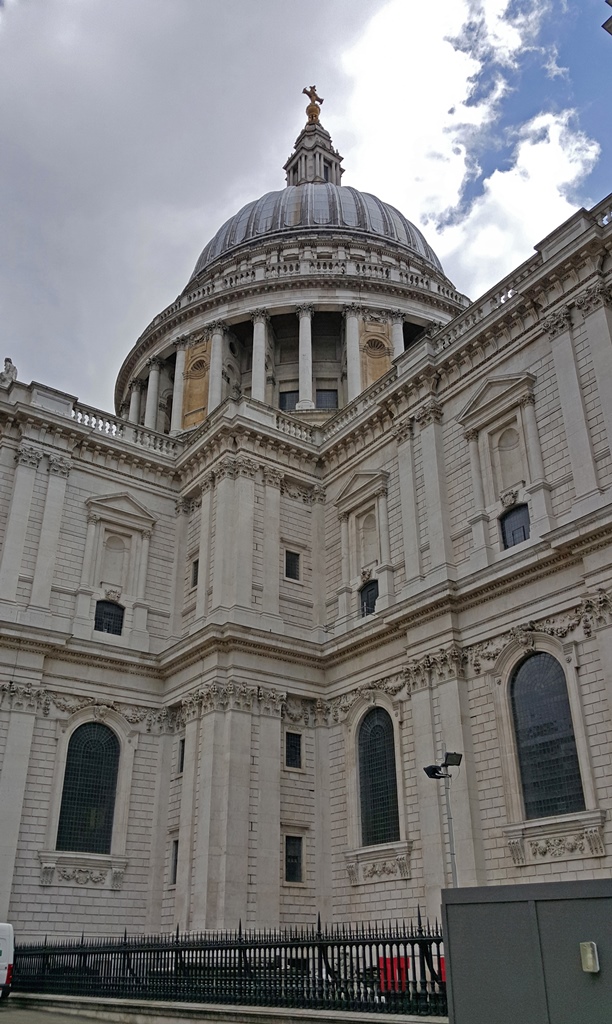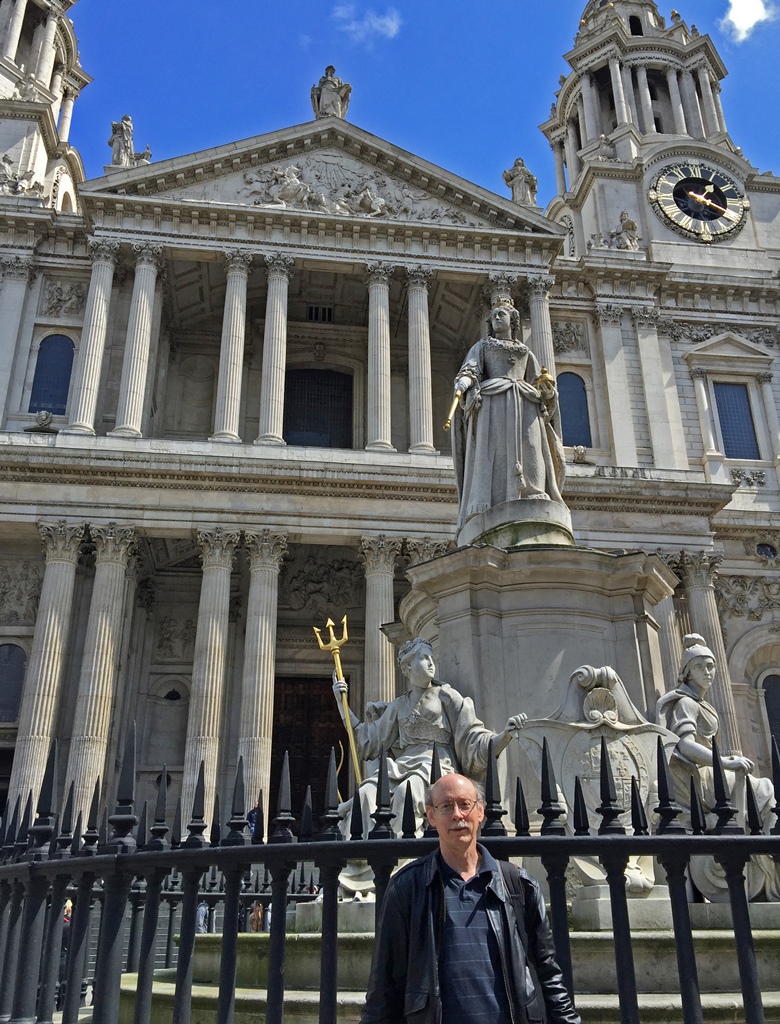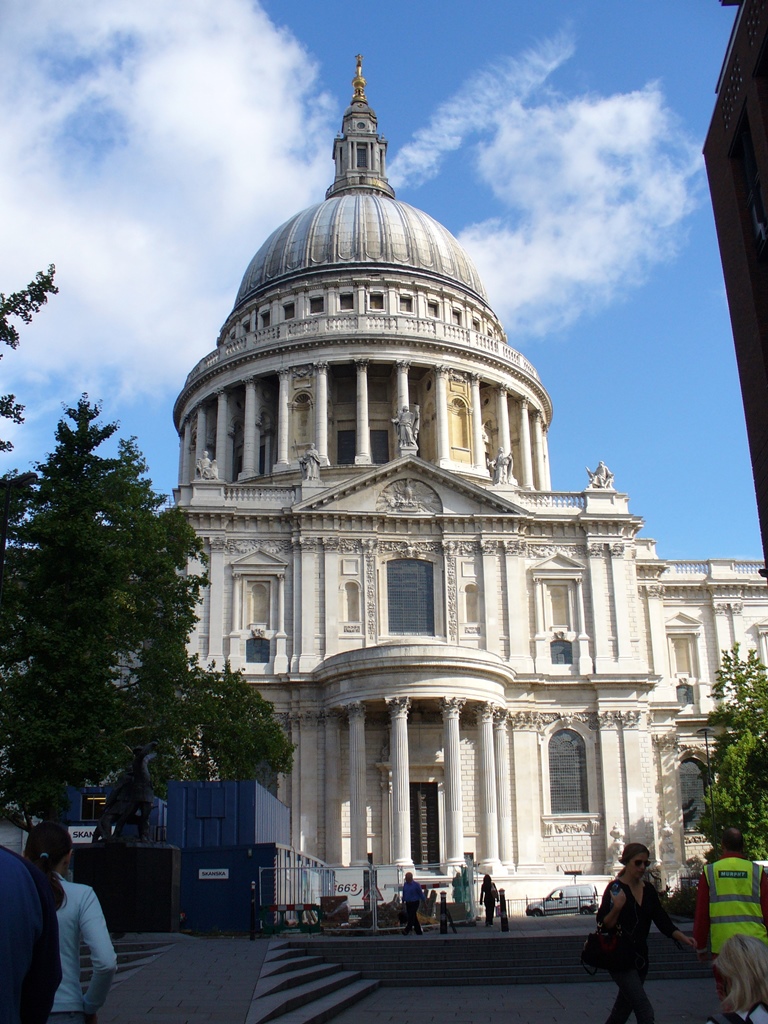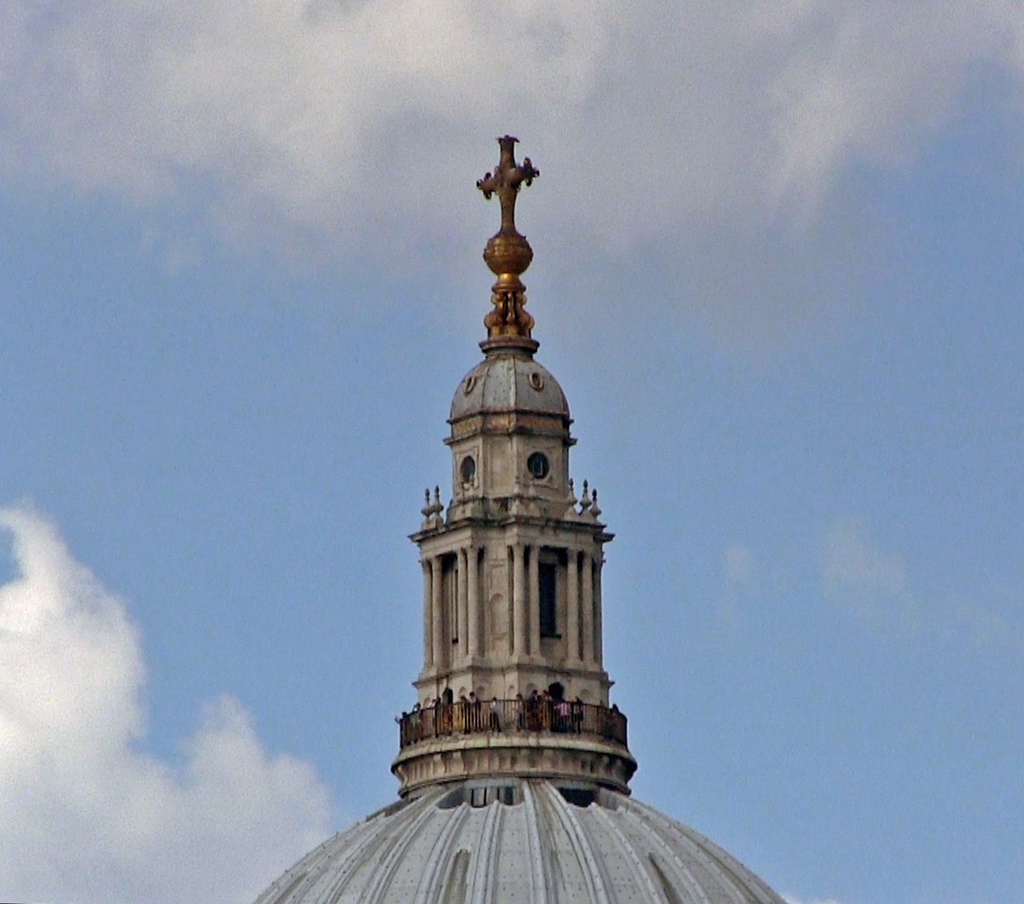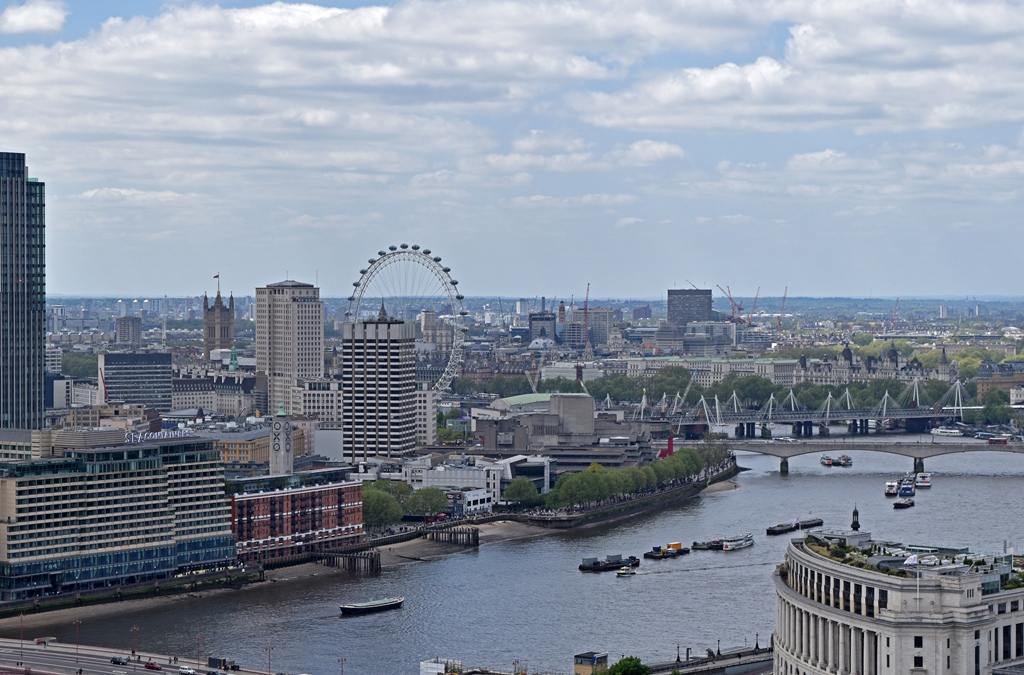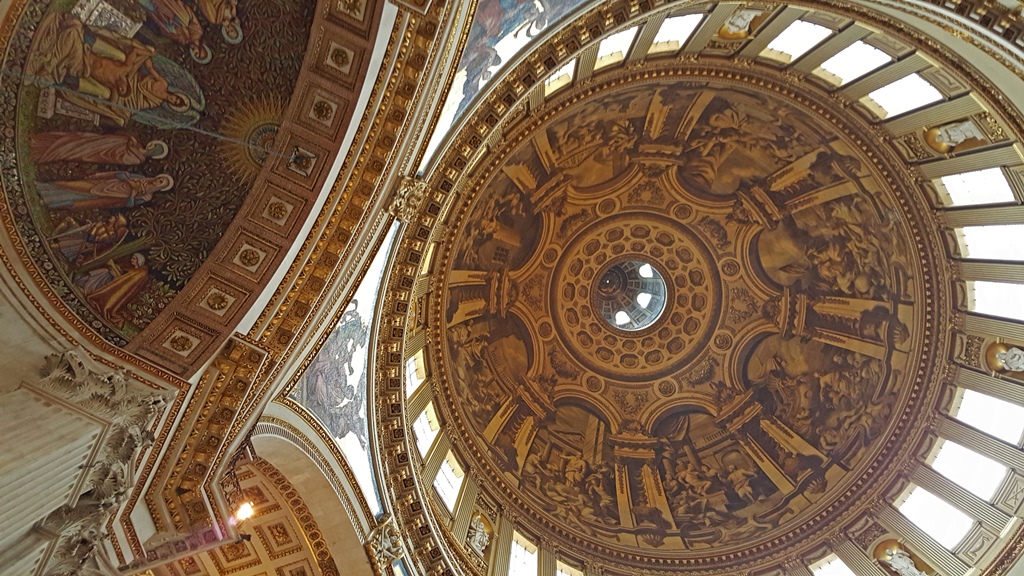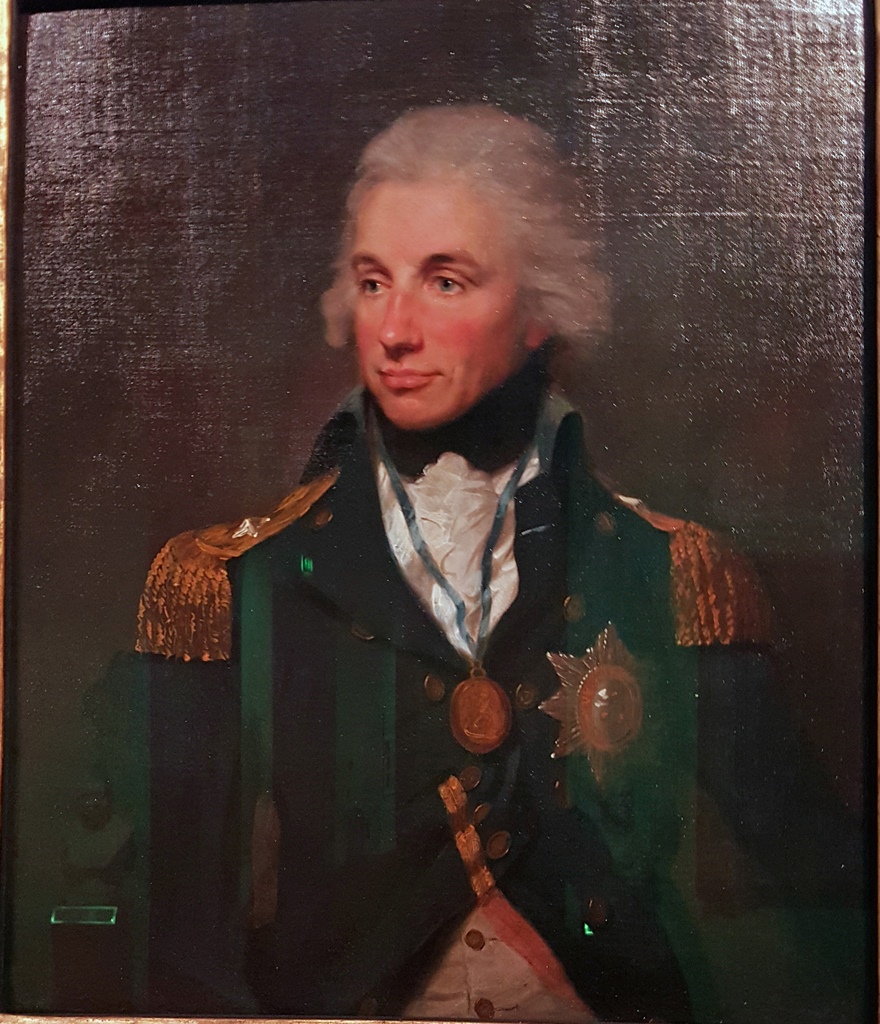St. Paul's Cathedral
St. Paul's Cathedral, built between 1675 and 1711, is an Anglican cathedral which is
the seat of the Bishop of London. It was built at the highest point in the original
City of London, on top of Ludgate Hill. At 365 feet high, it's long been an iconic part
of London's skyline, and was in fact the tallest building in the city between 1710 and
1967. St. Paul's and Westminster Abbey are the two most prestigious places of worship
in London, and St. Paul's has had its share of noteworthy ceremonies. Some of them have
included the funerals of Horatio Nelson (1805), the Duke of Wellington (1852), Winston
Churchill (1965) and Margaret Thatcher (2013), the wedding of Prince Charles and
Princess Diana (1981), a celebration of Queen Victoria's Diamond Jubilee (1897), a
celebration of George V's Silver Jubilee (1935), and celebrations of Queen Elizabeth
II's Silver (1977), Golden (2002) and Diamond (2012) Jubilees.
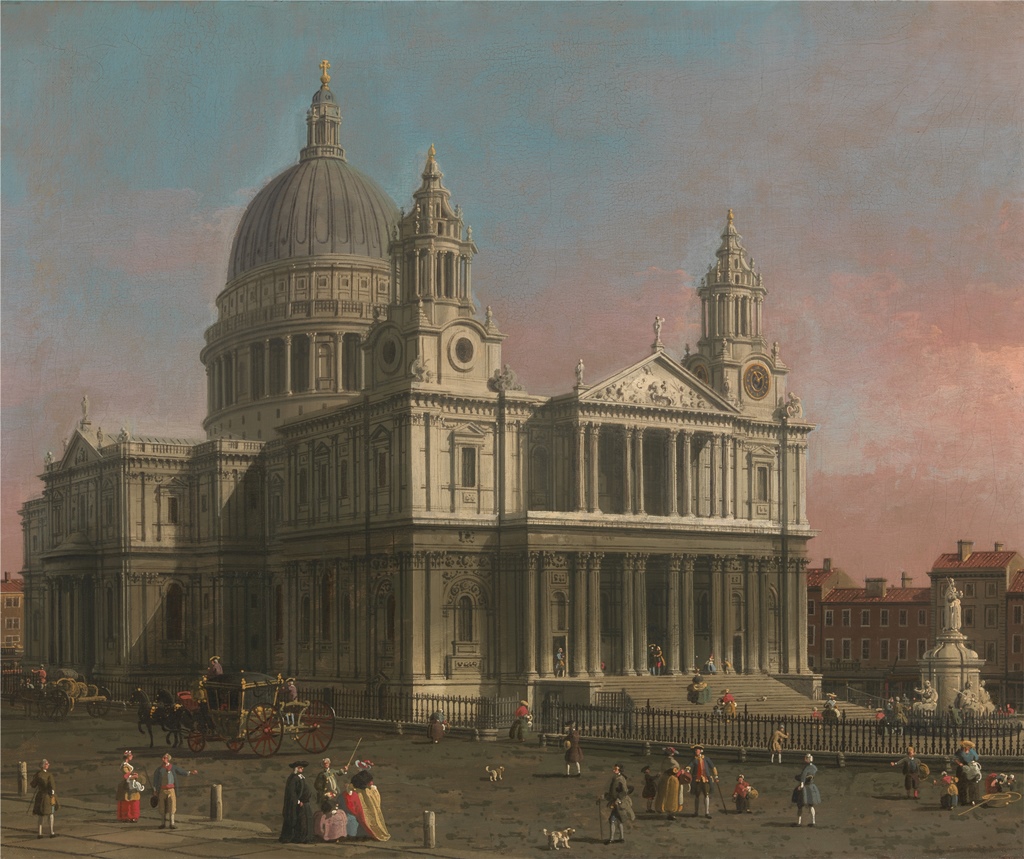
St. Paul's by Canaletto (1754)
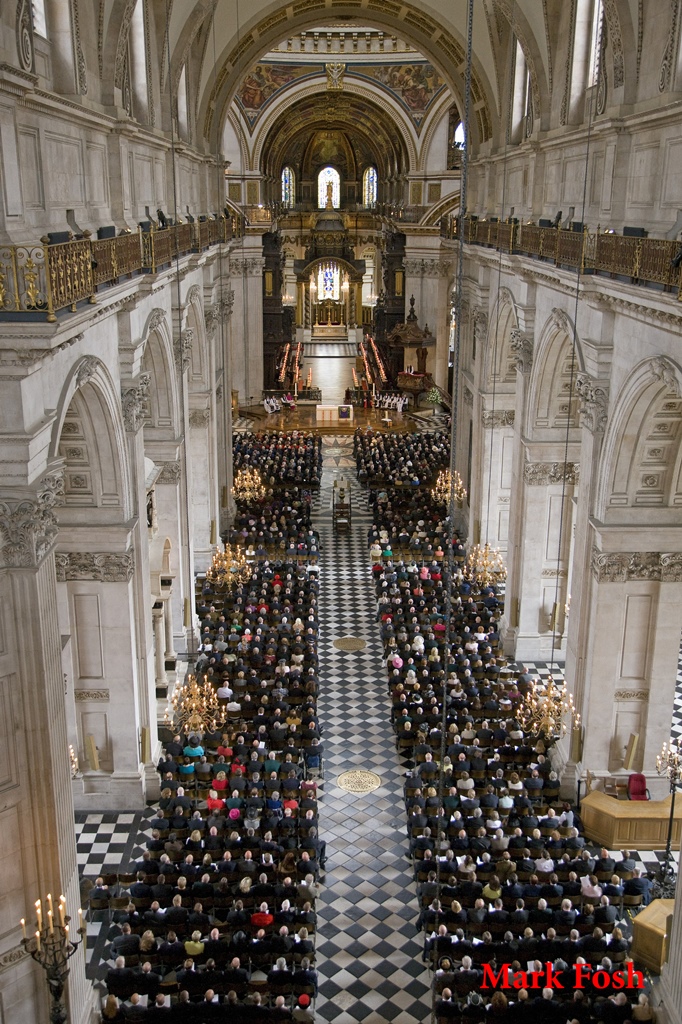
Ceremony in St. Paul's
The cathedral has also made appearances in several motion pictures, as an essential
part of the London backdrop. It played a more specific part in 1964's Mary
Poppins, in which an old woman sells birdseed from its steps.
The present building was not the first St. Paul-dedicated cathedral to be built on
the site. There was some sort of cathedral on the site as far back as the 7th
Century. This building, or a successor, was destroyed by fire in 962, but was
immediately rebuilt. A large fire in 1087 destroyed the replacement building,
along with much of the city. The Normans, who had recently conquered the country,
began a rebuilding project in Romanesque style, but after another fire in 1135,
they started over in Gothic, finally finishing in 1240. But unsatisfied, the 13th
Century management didn't take long to embark on an enlargement project, which was
completed in 1314. At this point the church had reached 585 feet in length and had
grown a steeple that was 460 feet tall.
The length of the nave made it something of a workout to walk from one end to the
other, and the nave acquired the popular nickname "Paul's Walk". It also became a
meeting place and even a marketplace, where people could go to hear and spread the
latest news and gossip. In 1554, the Lord Mayor issued a writ decrying the selling
of horses, beer and "other gross wares" in the cathedral.
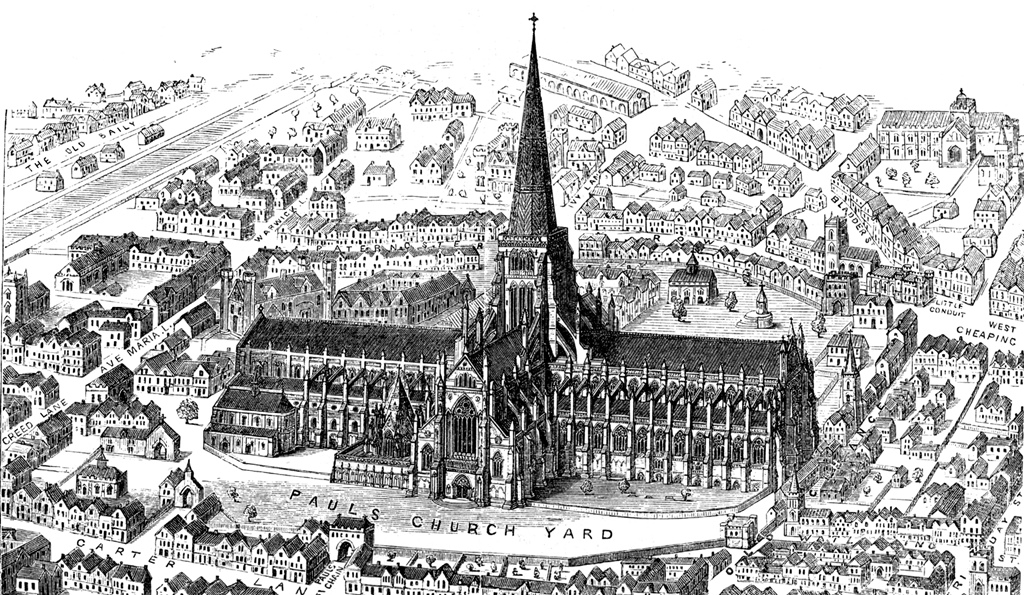
Old St. Paul's Before 1561
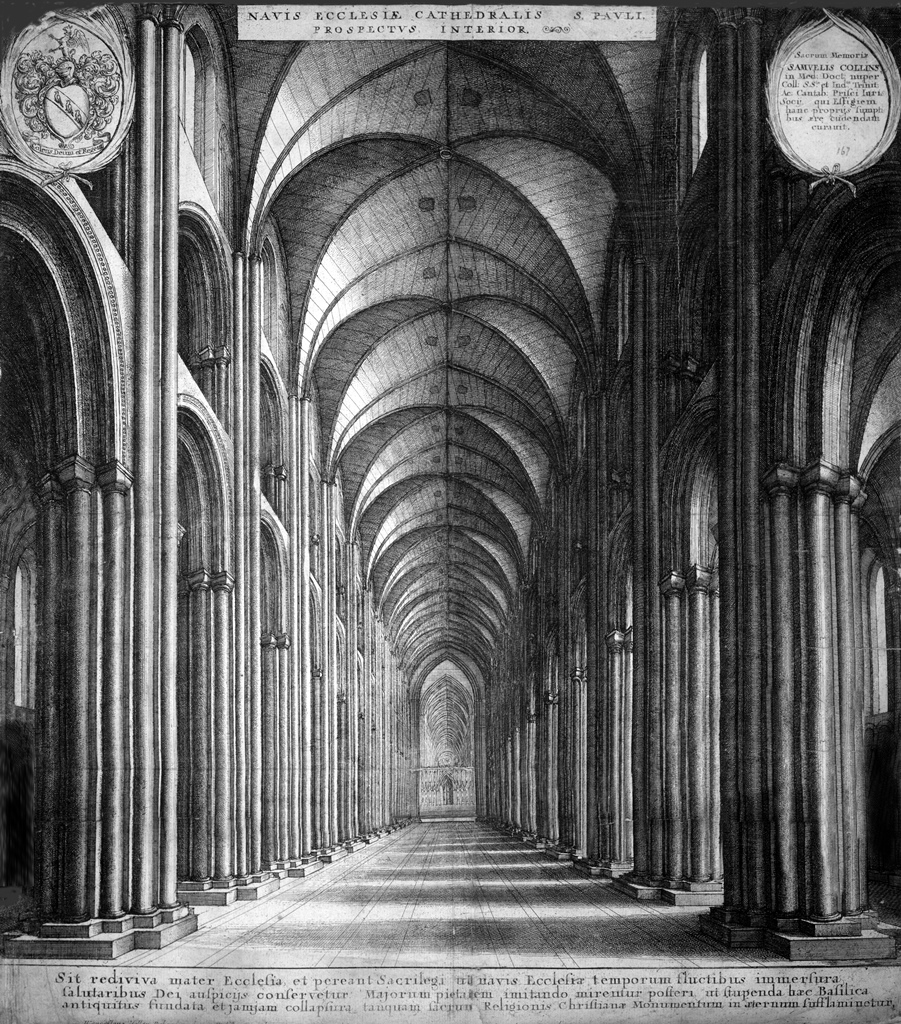
St. Paul's Walk
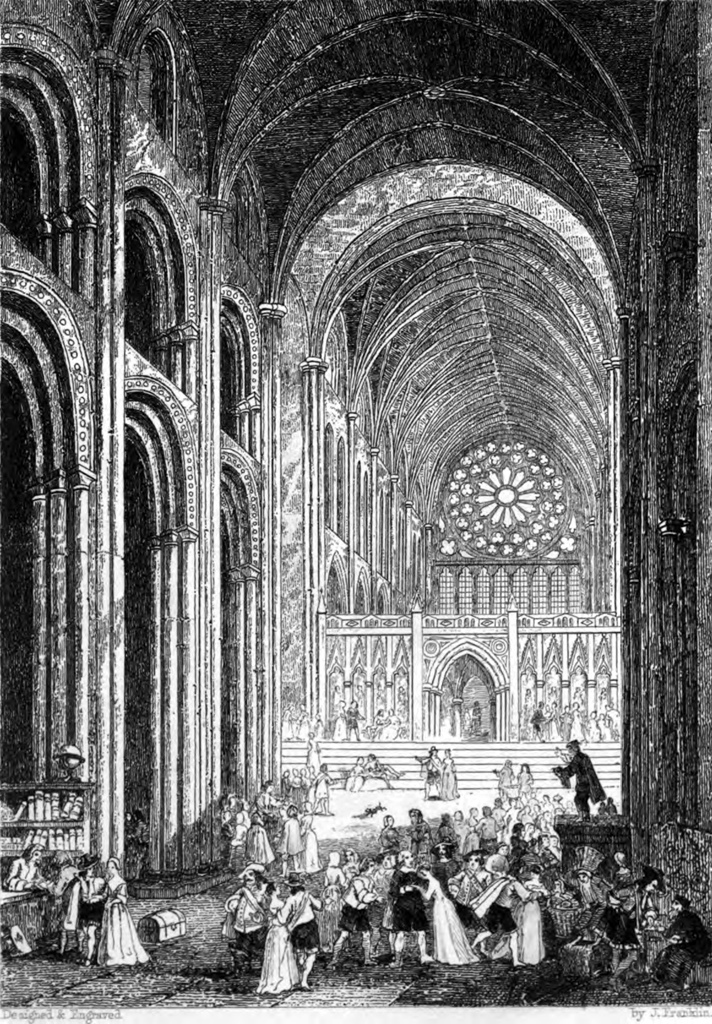
Commerce at St. Paul's Walk
In 1561 the church's spire fell victim to a lightning strike (something that shouldn't
have been much of a surprise, considering its height), and the resulting fire destroyed
both the spire and the roof of the cathedral. Repair work was less than comprehensive –
the spire was not rebuilt, being replaced by a stunted-looking tower which wasn't much
taller than the roof, and the roof repair was substandard, deteriorating to a dangerous
condition within 50 years. At that time, another restoration project was begun, under
Inigo Jones, England's first classical architect. Jones added an incongruous
classical-style portico to the gothic building while rebuilding other parts of the
structure. Work stopped when the English Civil War broke out in 1642, and the church
was subjected to abuse by Parliamentarian forces, who used it as a stable for cavalry
horses. After the Restoration of King Charles II in 1660, the effort to restore St.
Paul's was resumed, but not with Inigo Jones, who had died. A number of people were
involved in the effort, but the one who moved into the leadership role was named
Christopher Wren.
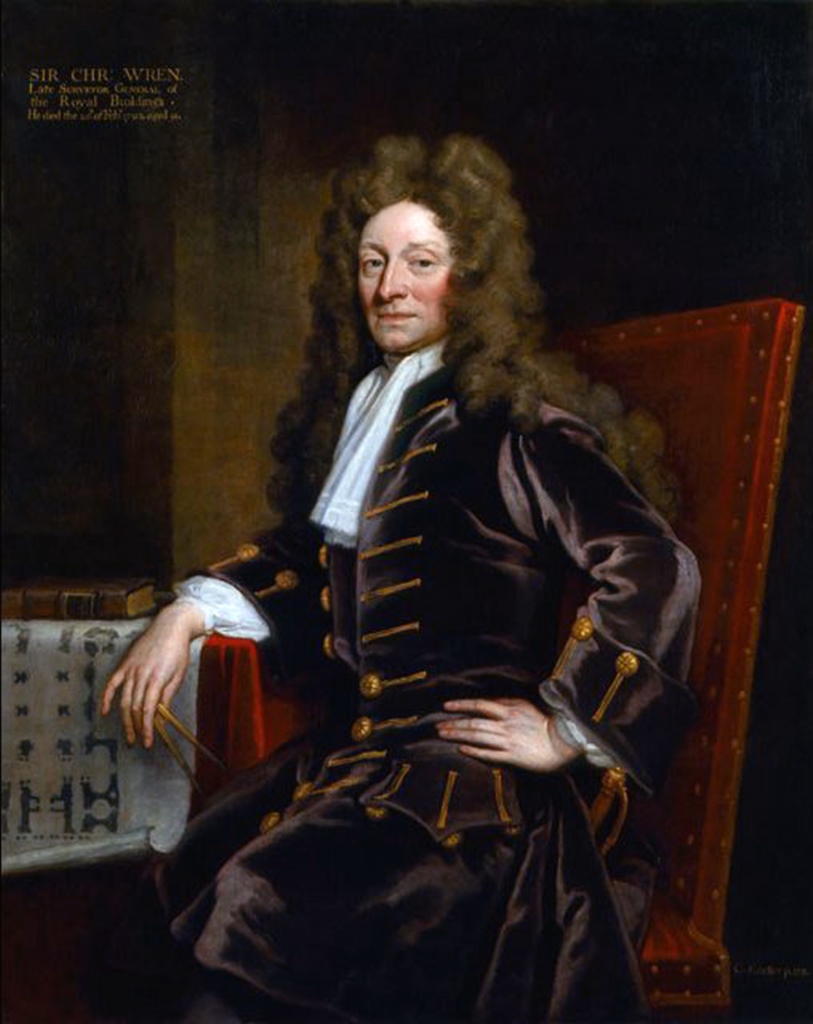
Sir Christopher Wren (1711)
Christopher Wren was not an architect by trade. Strictly speaking, architecture didn't
really exist as a trade in 17th Century England. Wren was a relentlessly curious man with
interests in many fields, including anatomy, astronomy, meteorology, mathematics and
physics, and was one of the founding members of England's Royal Society, the world's first
national scientific institution, established in 1660 via a royal charter from Charles II.
This being the case, Wren had been consorting with people like Robert Boyle, Robert Hooke
and Isaac Newton, but Wren's command of geometry, plus the nature of the ideas he'd been
presenting for the St. Paul's project, appeared to make him the right person at the right
time.
And "right time" became more emphatic in September of 1666, when the Great Fire of London,
started in a baker's shop, destroyed two-thirds of the City of London, including St. Paul's
Cathedral, which had been covered in flammable scaffolding in preparation for the
restoration project.
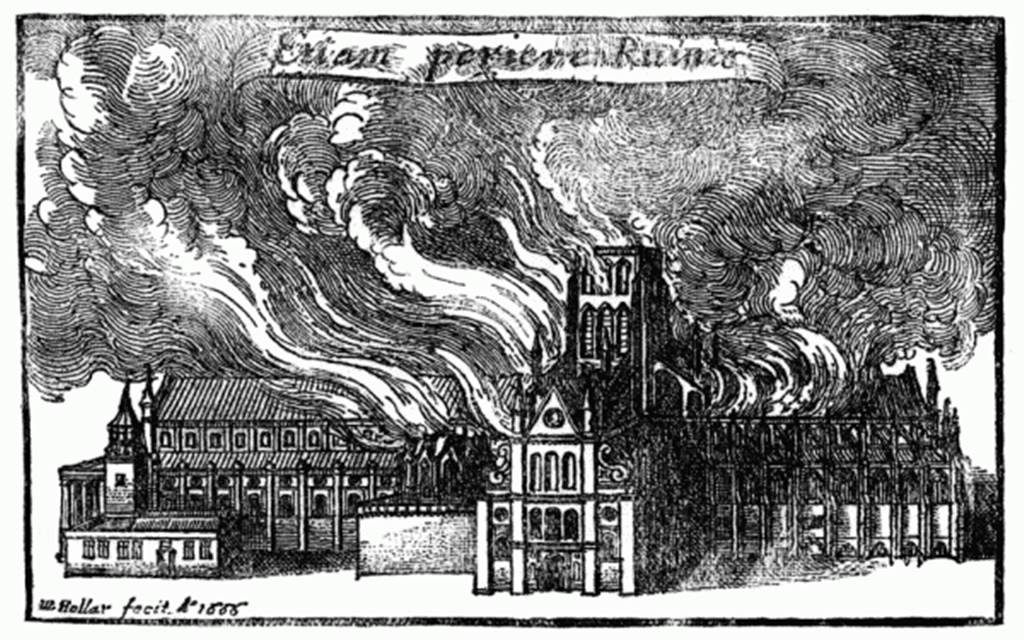
Old St. Paul's on Fire, 1666
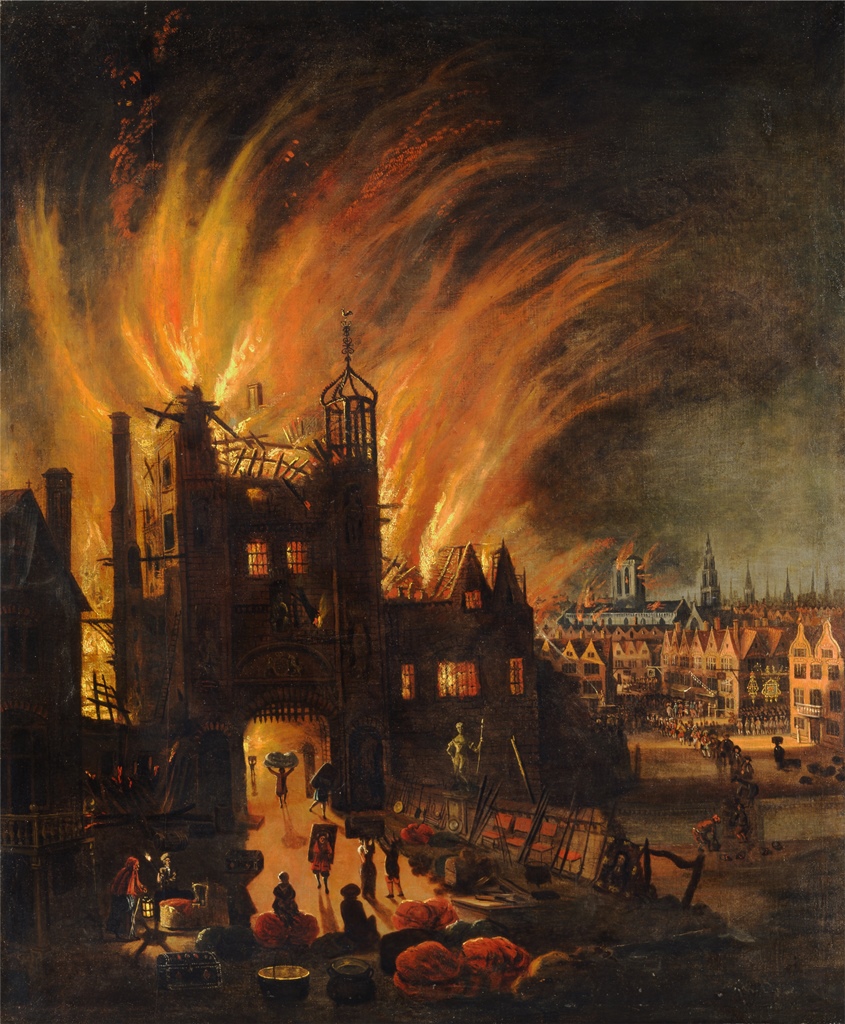
Old St. Paul's on Fire, 1666
Ruins of Old St. Paul's, 1673
After some agonizing over possibly salvaging some of the remains, it became apparent
that the project had transformed from a restoration project into a replacement
project. And not just replacement of the cathedral, but replacement of the many
parish churches that had been destroyed. All of this landed in the lap of Christopher
Wren, who was named the King's Surveyor of Works in 1669. His energy level must have
been tremendous, as he ended up building more than 50 parish churches, in addition to
assorted other projects, while leaving time for serving in Parliament for four terms
and for serving as President of the Royal Society for two years. And, of course,
building St. Paul's Cathedral. At first, there was a fair amount of trial and error
in the design work, as both the King and the clergy needed to approve it, and it was
proving difficult to satisfy everybody. Eventually a design was reached which
everyone could live with, and it came to be called the "Warrant" design. Fortunately,
the approval came with a loophole giving Wren permission to make adjustments to the
design that "proved necessary". He obviously took extravagant advantage of this
loophole.
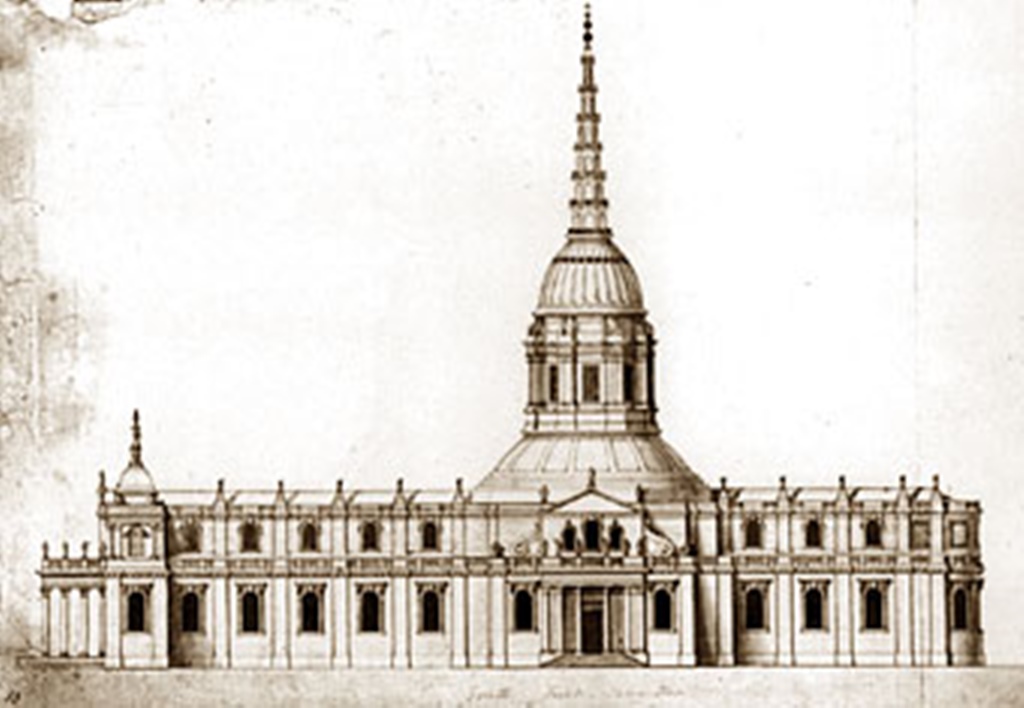
Approved ("Warrant") Design
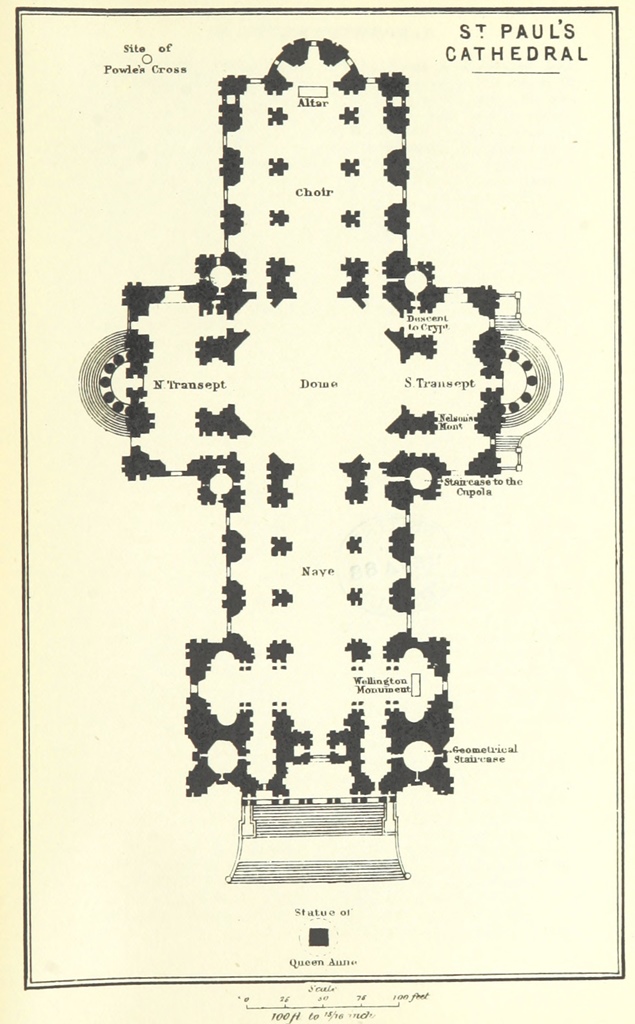
Eventual Layout of St. Paul's
Unusually for a cathedral of this scale, the architect lived to see the project
all the way through, from start to finish. The cathedral was declared complete in
1711, though low-level decorative work continued into the 1720's. Popular reaction
to the finished building was mixed to a degree. Some loved it, but others accused
it of having "an air of Popery". Fortunately it seems to have grown on people over
the last few centuries. Wren eventually died in 1723, at the age of 90.
The completion of the cathedral corresponded roughly with the beginning of the
Hanoverian dynasty, starting with King George I. George visited the cathedral once
and found the interior to be dim, cold and under-decorated, and did not return.
George II never visited at all, and George III didn't visit until 1789, as part of
a celebration of his recovery from an illness. Around this time, monuments started
appearing in the cathedral in an effort to generate interest. This worked somewhat,
but when Queen Victoria succeeded to the throne, she also complained about the lack
of decoration. Measures were taken – mosaics and stained glass were added, the
choir screen was removed to allow more access, and more of the building was used
for worship services. This made the building much more suitable for ceremonial
purposes.
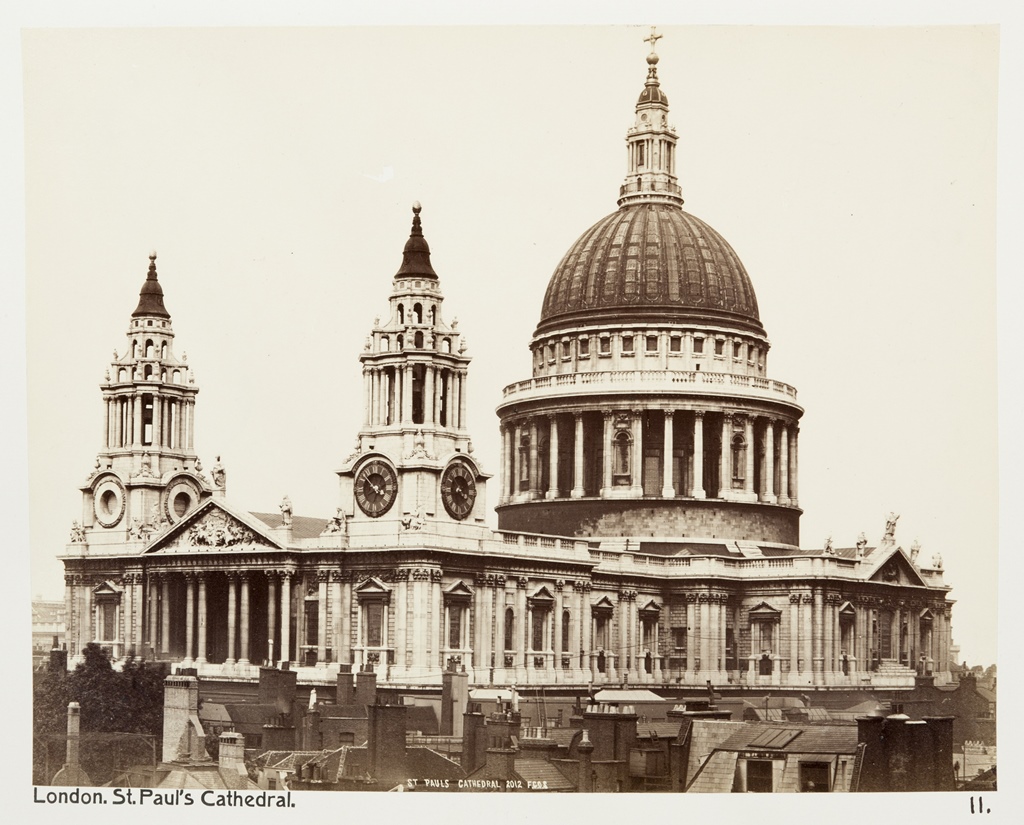
St. Paul's in 1886
During World War II, the cathedral was a target of enemy bombers on more than one
occasion. In 1940, a bomb struck the east end of the cathedral, destroying the
high altar, and in 1941, another bomb struck the north transept and left a hole
in the floor above the crypt. Also in 1940, there was a bomb that landed just
west of the cathedral (near a leaking gas main), which fortunately failed to
detonate. It was successfully defused by Royal Engineers and taken to a remote
area, where it was set off, leaving a 100-foot crater. The cathedral would
almost certainly have been destroyed if the bomb had gone off as planned.
Throughout the war, the cathedral was looked on as a symbol of the indomitability
of the British people. After the war, the damage was repaired, and a chapel was
added at the east end that was dedicated to the 28,000 Americans stationed in the
United Kingdom who died during the war.
Bomb Damage Around St. Paul's, 1945
Moving on to 2016, Nella and I had advance tickets (slightly discounted on the
cathedral website) to visit
St. Paul's. We took the Underground to the St. Paul's stop, a little northeast of
the cathedral, and approached by way of St. Paul's Churchyard.
Cathedral from St. Paul's Churchyard
We walked over to the west side, where the entrance was, but had to continue down the
street to get a decent picture of the façade, as it was so massive.
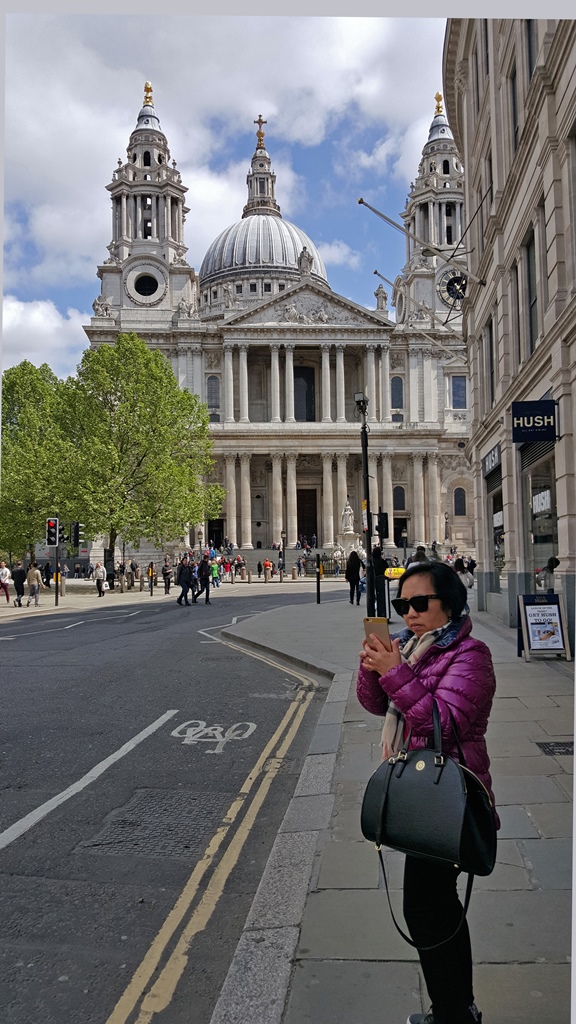
Nella with Cathedral
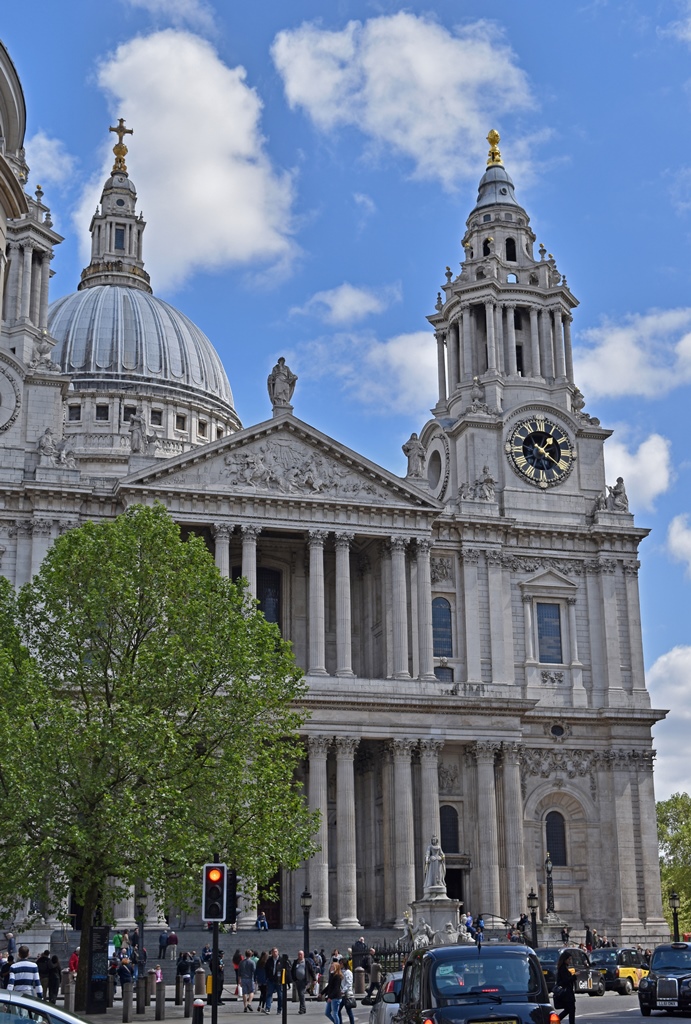
Cathedral from Across Street
We came back to the western steps, where we found a statue of Queen Anne, who was
the ruling British monarch when the cathedral was finished in 1711. This statue
is an 1886 copy of a 1712 original by Francis Bird, which was removed due to
weathering (it's now at a house near Hastings). It's surrounded by four statues
(also copies) representing Britannia, France, Ireland and
North America. The statues are loomed over by the façade of the church,
which is mostly classical in style, by way of English Baroque. There is a
pediment (also by Francis Bird) depicting the Conversion of St. Paul.
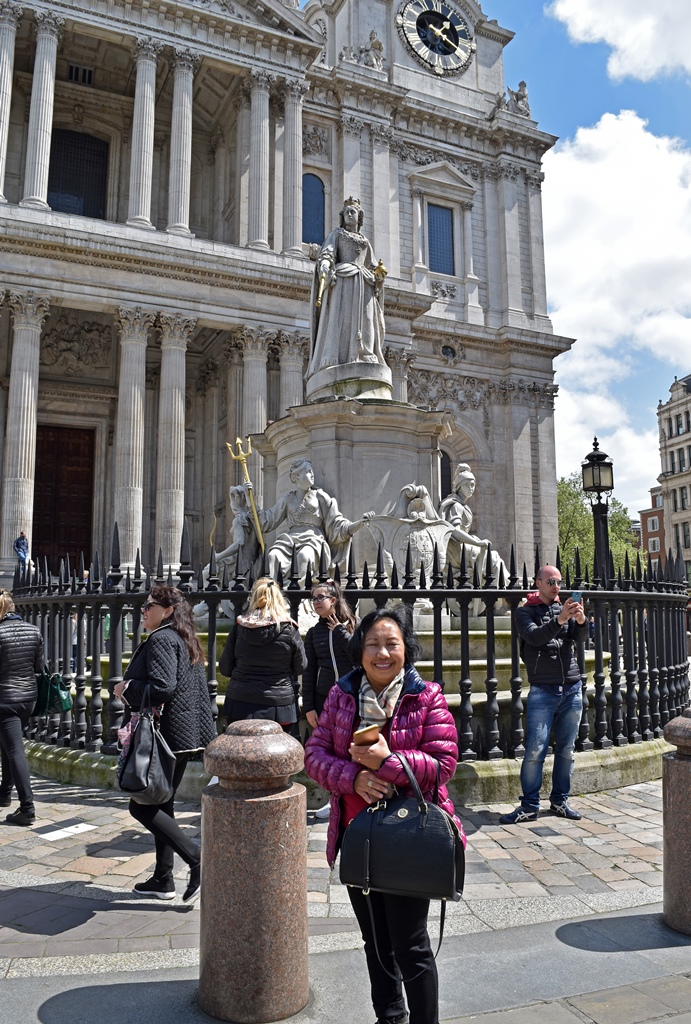
Nella and Queen Anne Statue
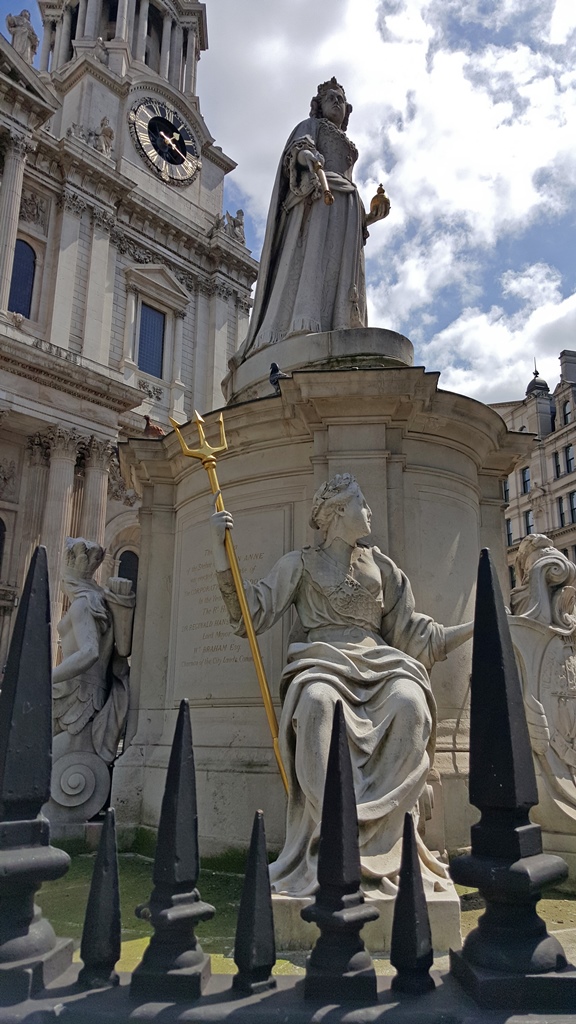
Queen Anne and Britannia Statues
Bob, Queen Anne and Cathedral Façade
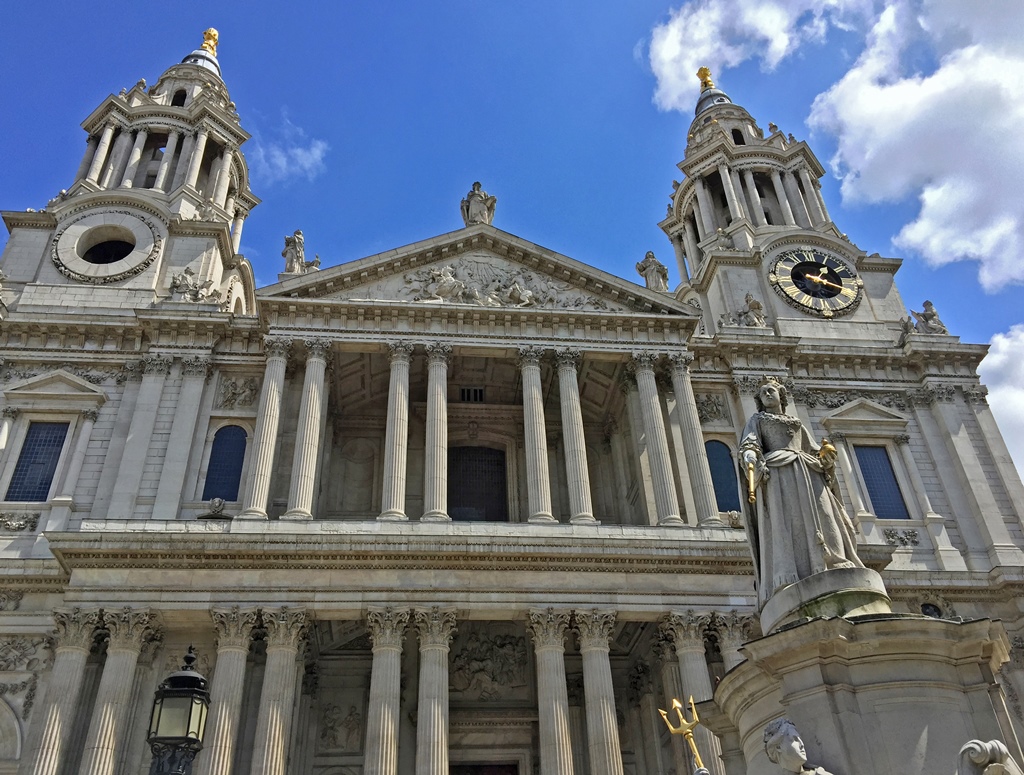
Cathedral Façade
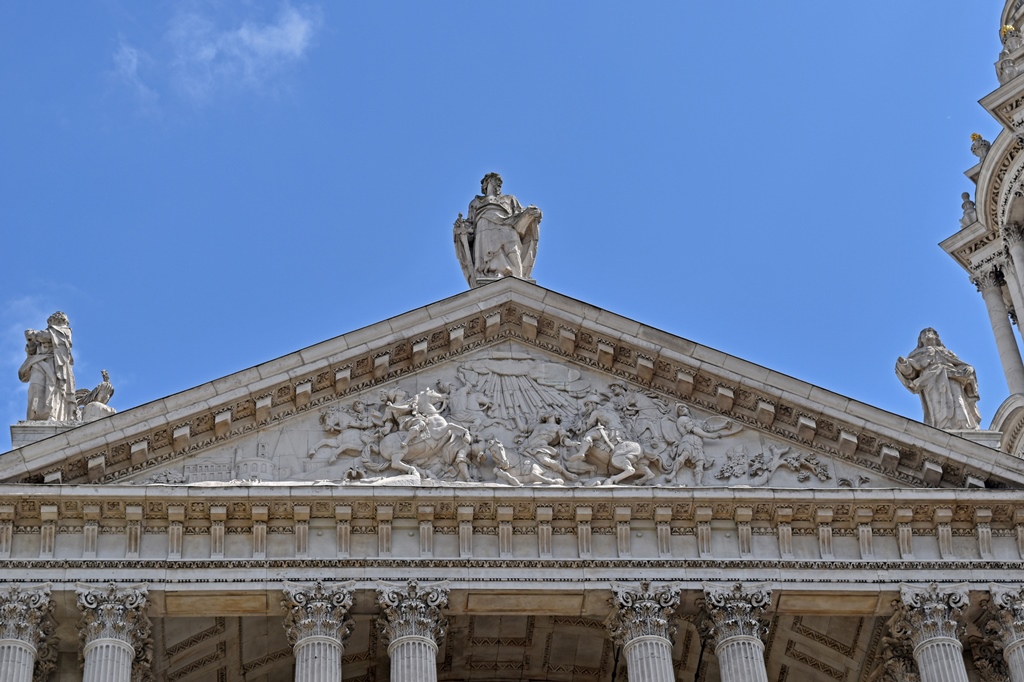
Pediment
We entered the cathedral and headed for the admission counter, where we presented
our tickets and were handed audioguides. At the time, there was a rule against
taking pictures inside the cathedral (I gather this rule has been relaxed somewhat
since 2016), so we decided we would start by climbing the dome. The outside of
the dome has walkways at two different levels. In the picture below, you can see
a sort of balustrade on top of the columns that circle the dome toward the bottom.
The first walkway is inside this balustrade. The second walkway is inside a
railing at the base of the lantern on top of the dome. One thing the dome
doesn't have is an elevator. There are lots of stairs, though.
Dome of St. Paul's
After our first climb, we came out on the lower walkway, breathing heavily but
not dangerously so. There were fine views in all directions, though we had to
peek through the balustrade to see anything.
Nella and Balustrade (view to east)
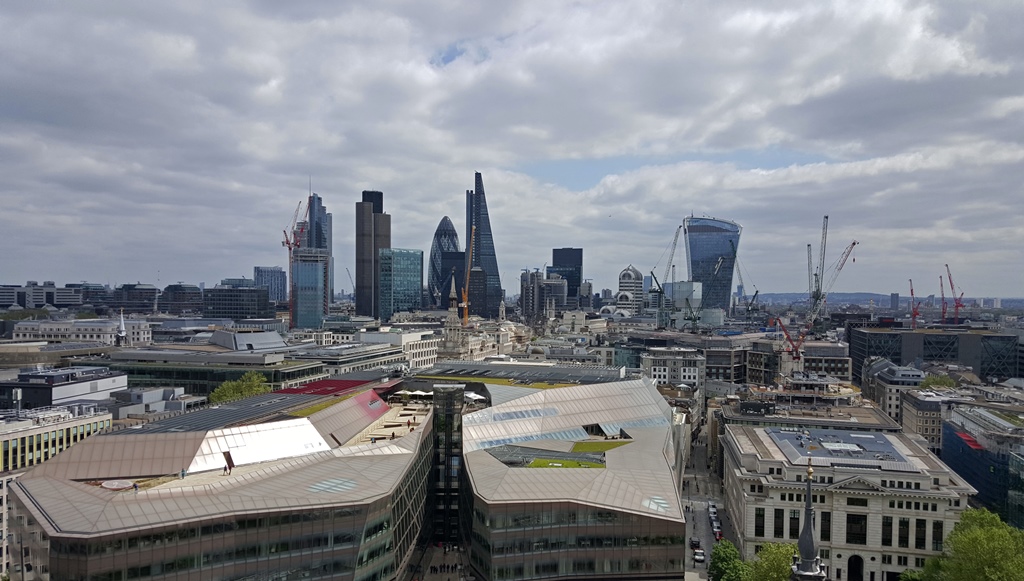
Financial District (East)
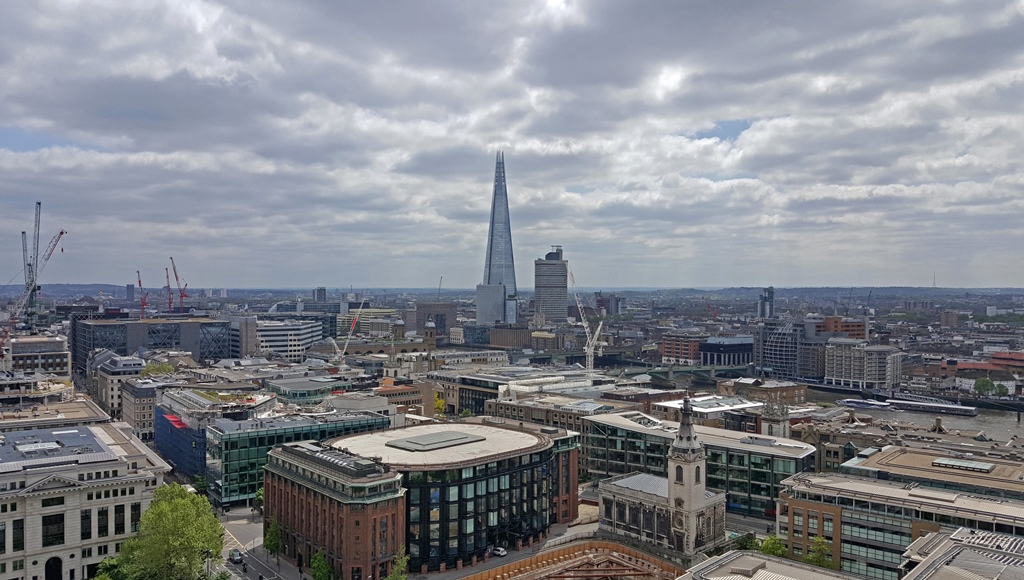
Shard and Thames (Southeast)

Nella with View to Southeast

Millennium Bridge, Thames and Tate Modern
After walking all the way around the dome, we decided to go for the upper walkway,
so we entered the doorway with the sign pointing up. As you can see in the
diagram below, the dome is actually two domes, one inside the other. The stairway,
not shown, is in the space between the domes. Also not shown is a cone-shaped
structure between the domes that encloses the lower dome. This structure
apparently gives the dome its strength, and there is a small room at the top of the
cone. In this room there is a small peephole, through which you can look down to
see the floor, about 300 feet straight down.
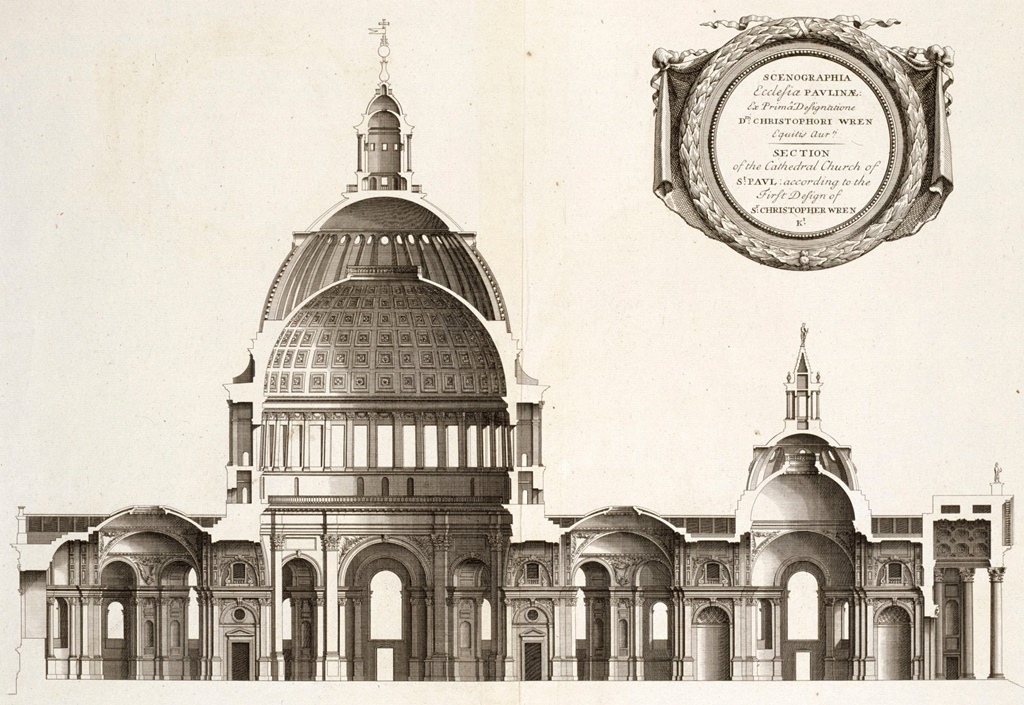
Cross-Section of Cathedral
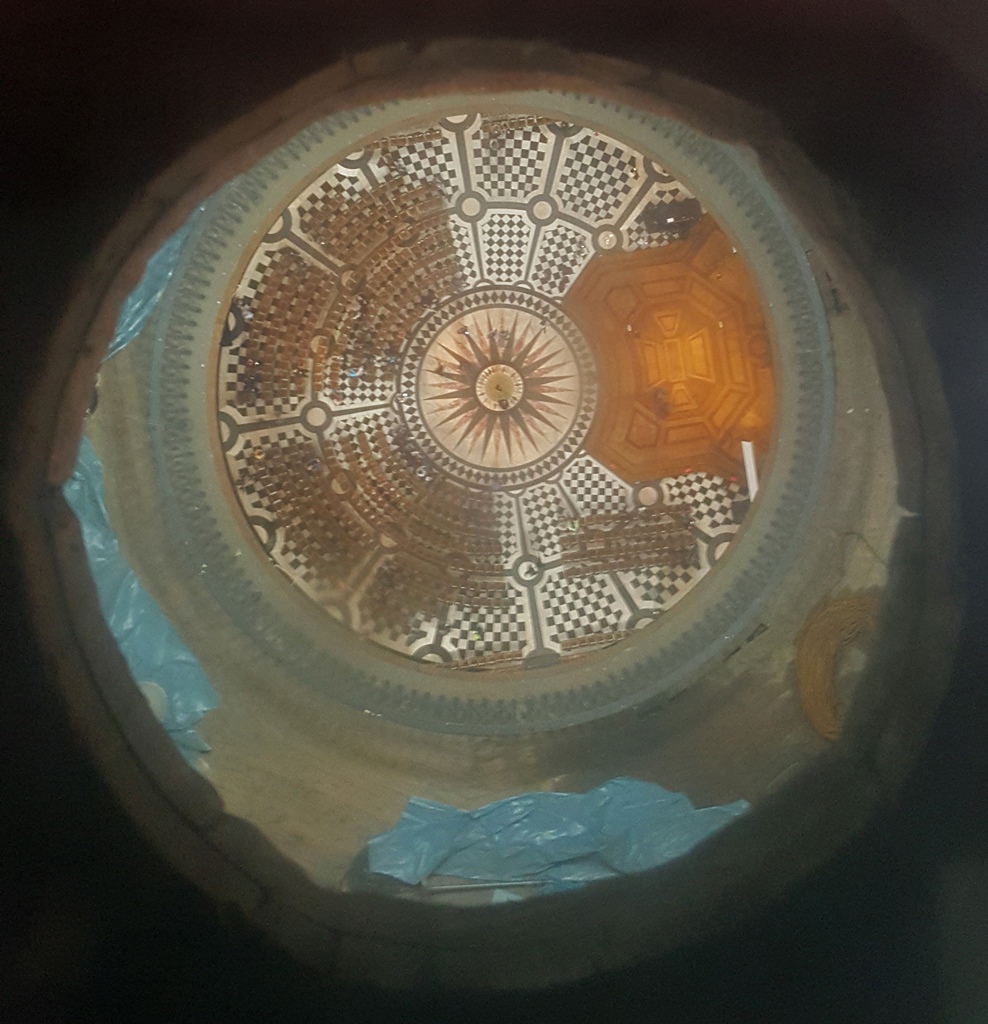
Cathedral Floor Through Peephole
We continued up the stairs and reached the upper walkway, which was a lot more
cramped than the lower one.
Cathedral Lantern
Cramped or not, the view from this walkway was even better than the view from
the lower one. First, we were higher, and second, we didn't have a balustrade to
look through – we could just look over the railing.
Thames, Bridges and London Eye (Southwest)
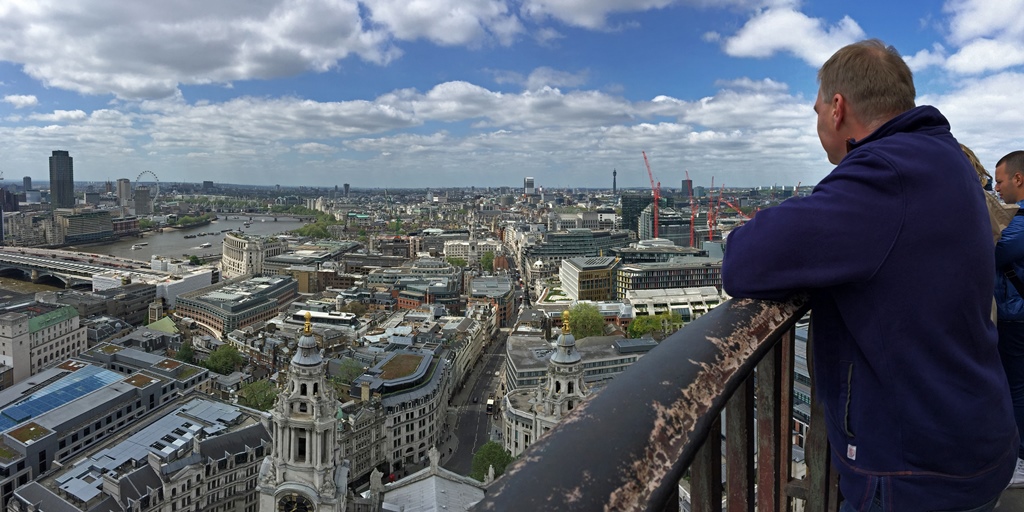
West from Top of Dome

Cathedral Towers and View West

Panoramic View to Southwest
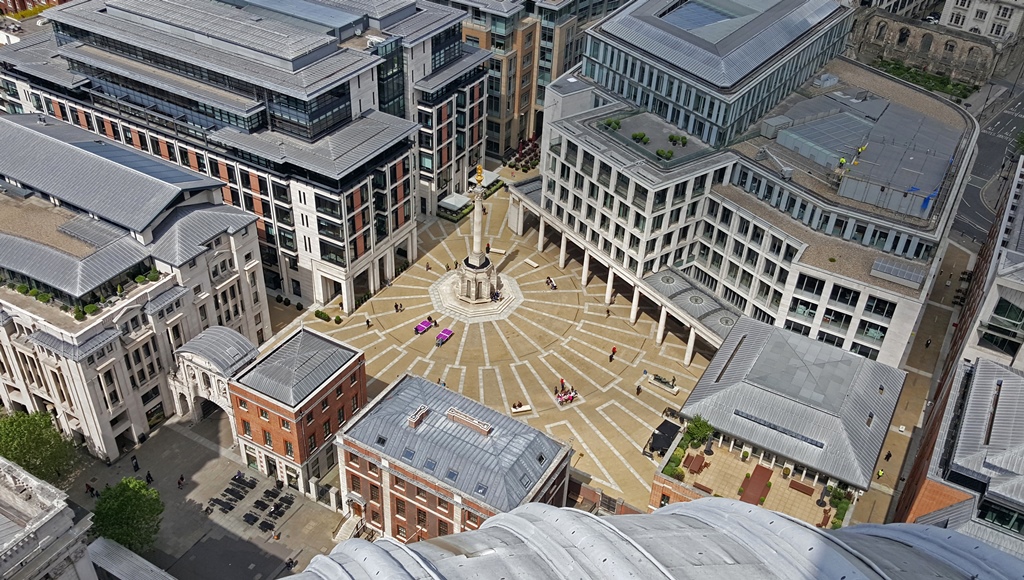
Paternoster Square
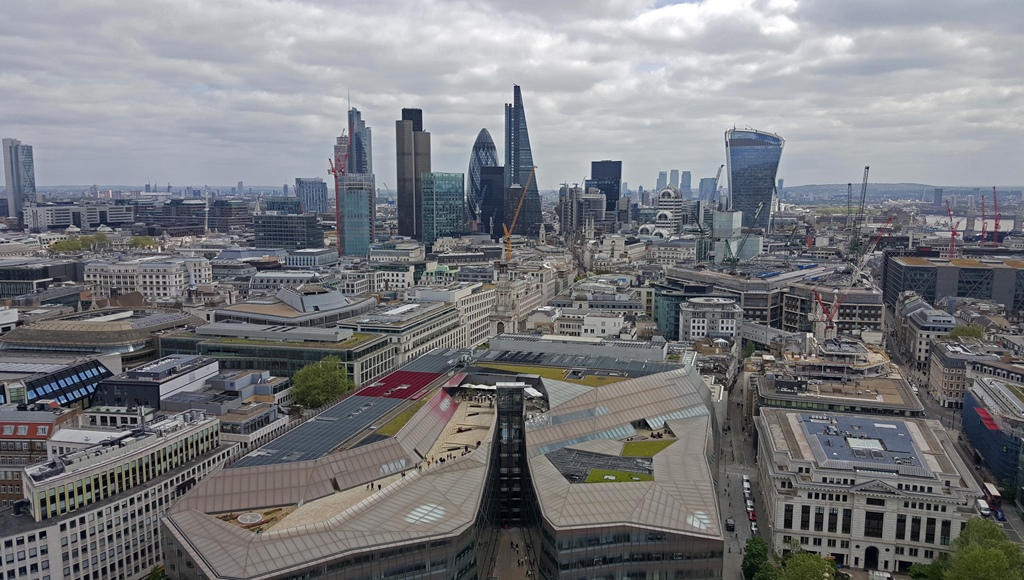
Financial District (East)
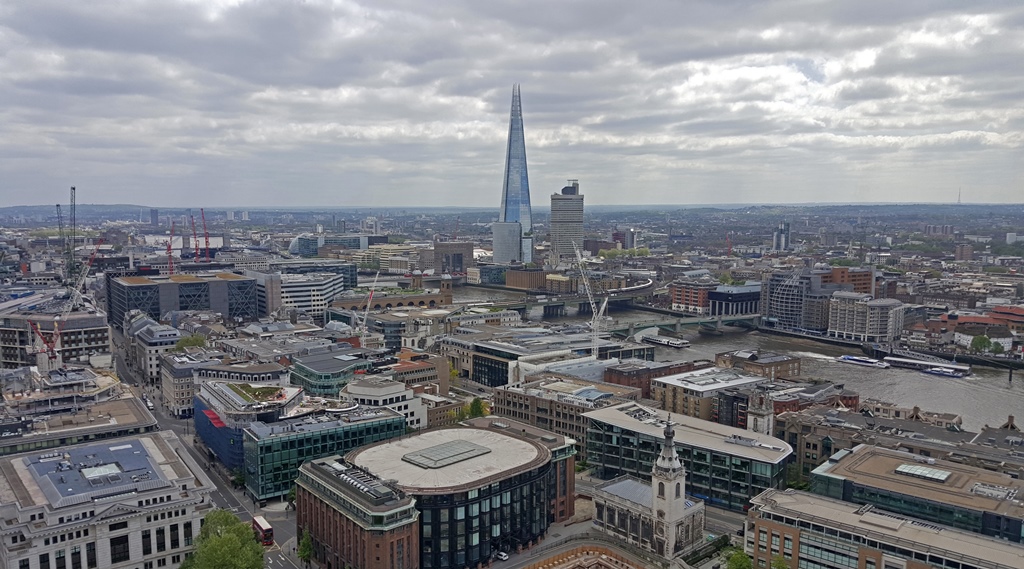
Shard and Thames (Southeast)
After having seen enough, we headed back down the stairs until we came out on a
walkway at the base of the dome, but inside it. This walkway is called the
Whispering Gallery, because supposedly a whisper against its wall can be heard at
any other point along the wall. We didn't know about this at the time, so we
didn't try it. But the view of the inside of the cathedral was nice from this
point, as it was about 100 feet above the floor. We weren't sure if we were
allowed to take pictures from here or not, so we only took a couple.
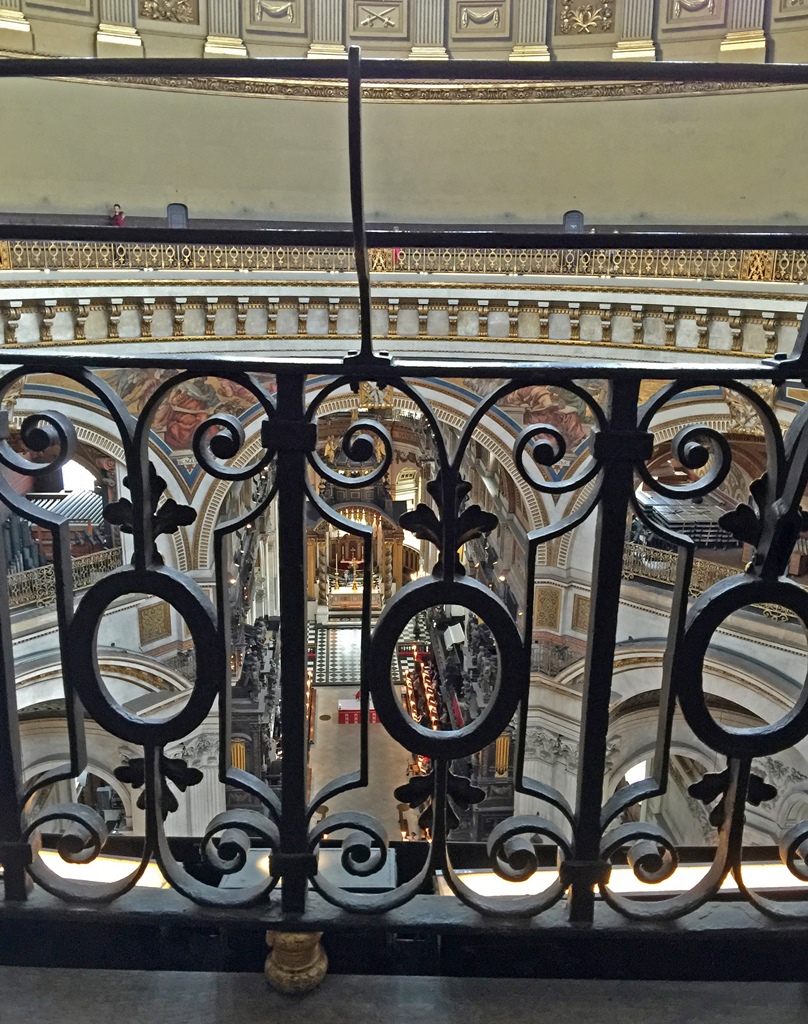
Cathedral Interior from Whispering Gallery
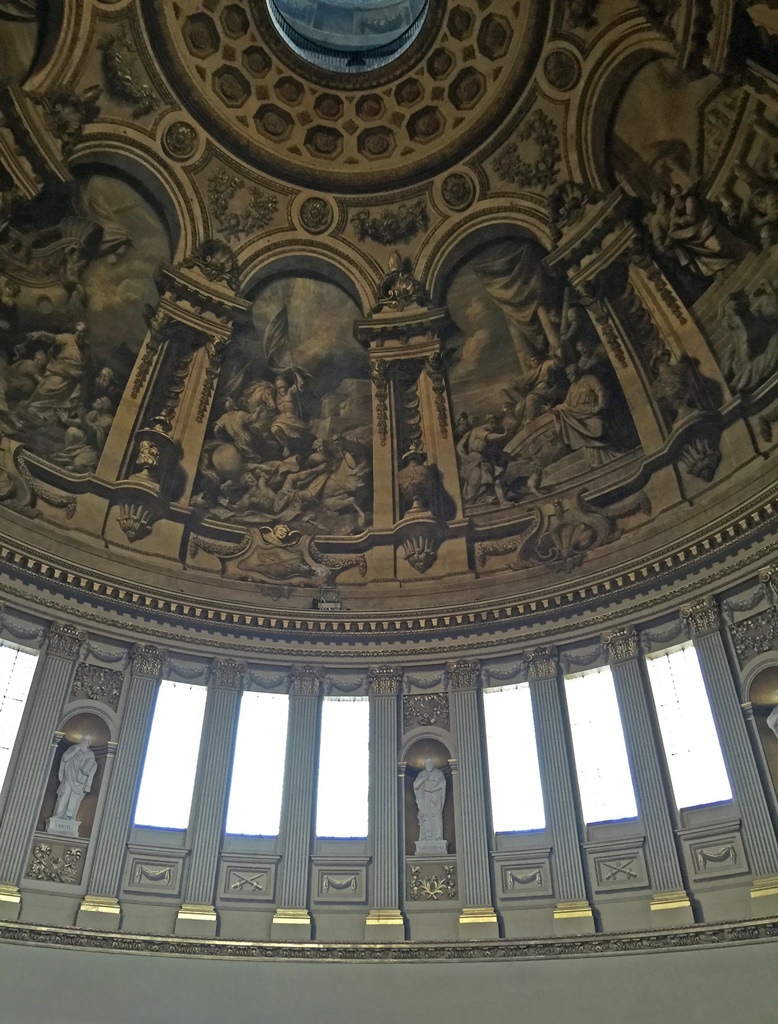
Dome from Whispering Gallery
We continued down the stairs and found some chairs arranged under the dome. We sat
down for a short rest. I accidentally took a picture of the dome.
Dome from Ground Level
After looking around the cathedral awhile, we found some more stairs, leading
downstairs into the crypt. Here we found the tomb of Horatio Nelson, directly
underneath the dome. Nelson was killed by a sniper during the Battle of
Trafalgar in 1805, making the battle both a great victory and a great loss for
the country. Accordingly, there was a large funeral at St. Paul's, attended
by thousands. Near Nelson's tomb was the tomb of the Duke of Wellington, who
defeated Napoleon's land forces. Wellington was able to survive the war,
though, and eventually served two terms as Prime Minister (as a Tory). While
Prime Minister, he worked successfully for Catholic Emancipation, in
opposition to many in his own party. He died in 1852 at the age of 83, also
receiving a state funeral.
Vice-Admiral Horatio Nelson
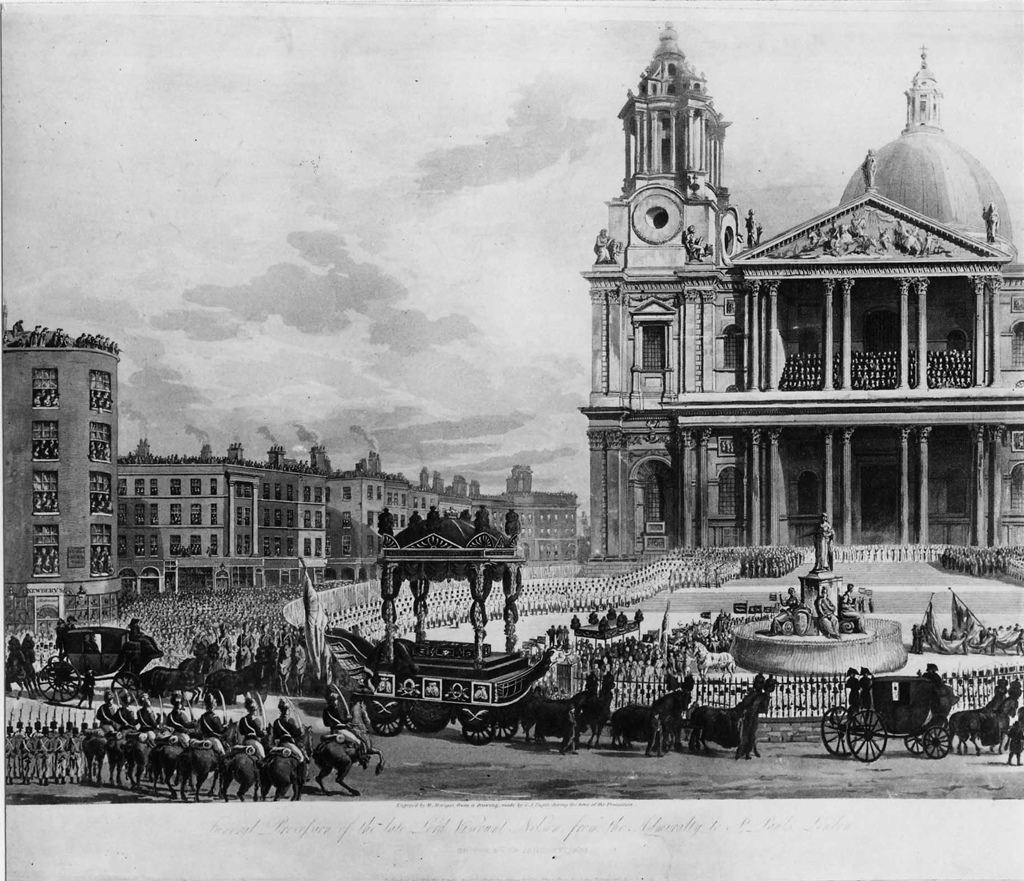
Nelson's Funeral, 1805
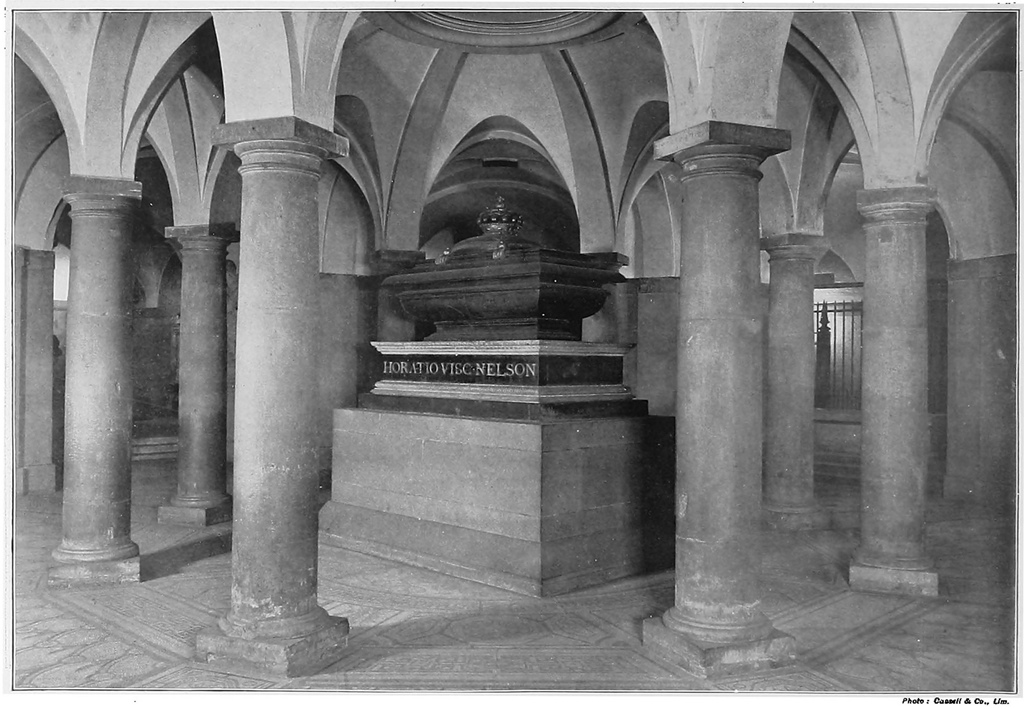
Horatio Nelson's Tomb
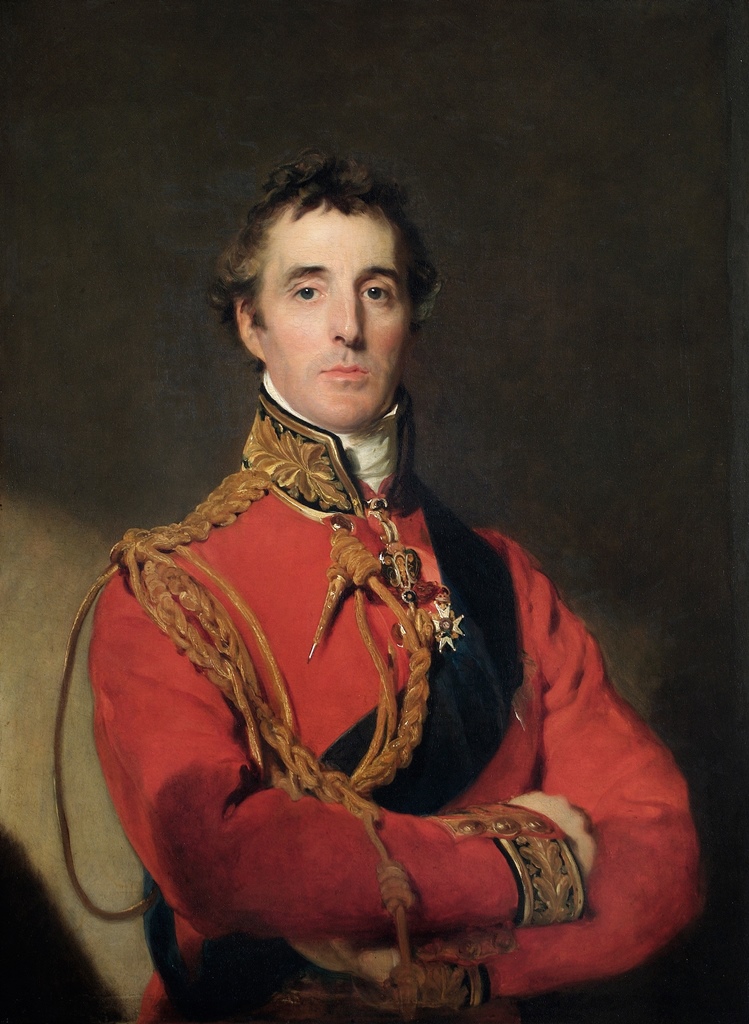
The Duke of Wellington
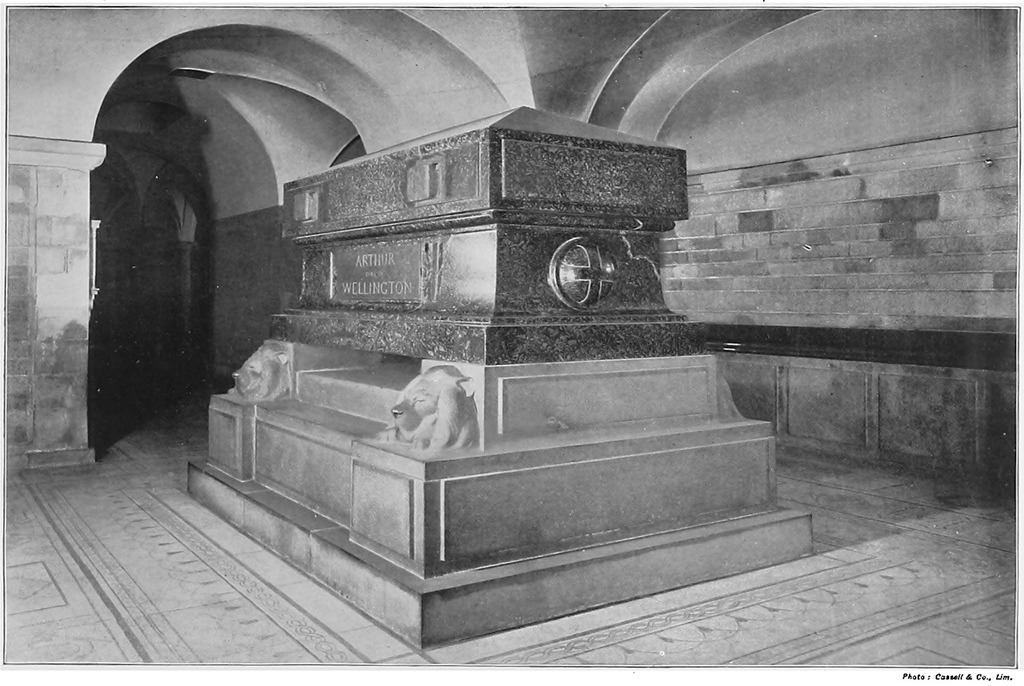
The Duke of Wellington's Tomb
Another resting place of note is found in the crypt's southeast corner. This is the
modest burial place of Sir Christopher Wren. A plaque, with inscription written by
his son, Christopher Wren, Jr., reads in part, "Reader, if you seek his monument –
look around you."
After finishing with the crypt, we returned our audioguides and left the cathedral.
We hopped back onto the Underground (minding the gap, of course) and headed for our
next destination: Trafalgar Square, and the National Gallery.

